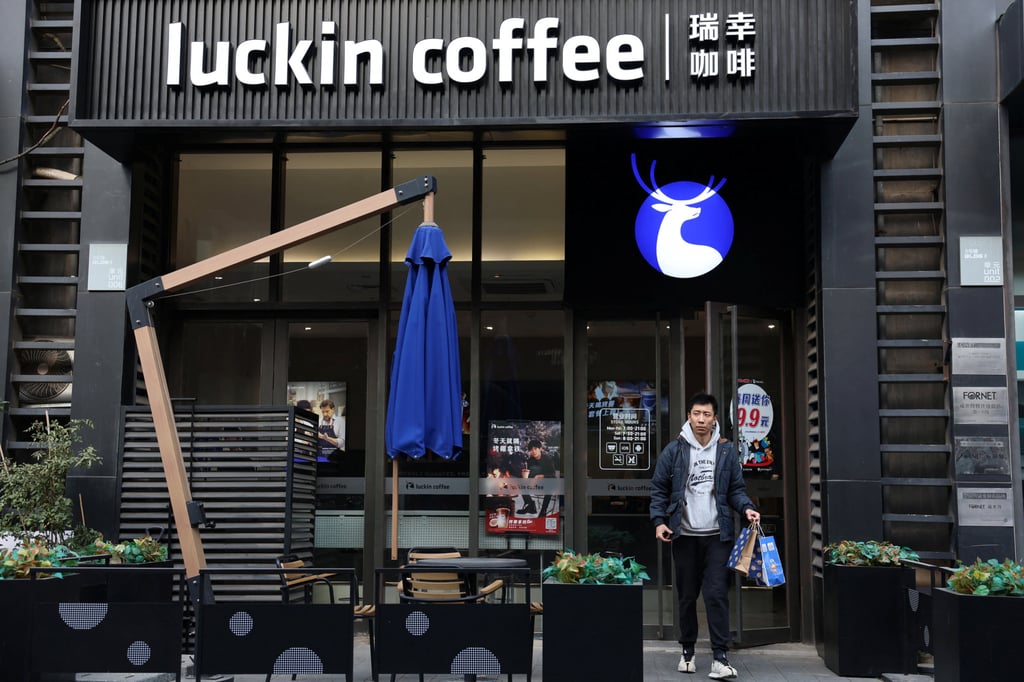The shift has added to pressure on the American coffee giant, which opened its first shop in China in 1999, especially as China has overtaken the US as the world’s biggest market for branded coffee shops in terms of outlet numbers, according to a report by World Coffee Portal late last year. The total shot up by 58 per cent last year to 49,691 outlets.
Founded in 2022 and helmed by Luckin Coffee’s former chairman Lu Zhengyao, Cotti has taken the market by storm with its all-encompassing 9.9 yuan (US$1.40) coffee menu and aggressive franchise-focused expansion strategy. Starbucks’ prices vary significantly depending on the product, but a tall latte, one of the most popular items, costs around 30 yuan.
Cotti has opened 7,500 stores in just under two years and pledged to build an additional 8,000 “express stores” in the second half of this year. Its tiniest shops, some as small as 1 square metre, are nestled inside convenience stores and restaurants, with minimal staffing and low costs.
Starbucks, in contrast, added only 826 new stores so far this year, representing a 13 per cent annual expansion, a pace that analysts describe as “much slower” than its domestic peers.
“Starbucks will continue to lose market share in China over the near term, driven in no small part by consumer trade-down and more cost-effective options widely available with local competitors,” Sean Dunlop, a senior equity analyst at Morningstar, wrote in a note.
The US coffee brand’s same-store sales in China are expected to decline by 12 per cent in the fiscal fourth quarter, resulting in a 7.2 per cent drop for the full year. Meanwhile, the company’s new stores are estimated to generate a 50 per cent cash return on investment, much lower than the 70 per cent enjoyed just a couple of years ago, Dunlop said.
Starbucks’ global CEO Laxman Narasimhan expressed dissatisfaction with the results in an earnings call last week, attributing the decline in China to “significant disruptions” in the operating environment caused by “unprecedented expansion and a mass segment price war”.
Cotti Coffee’s aggressive pricing and expansion strategies are hurting more than just Starbucks. Luckin, China’s biggest coffee chain with more than 20,000 outlets, saw its second quarter profit drop 12.8 per cent year on year to 871 million yuan, despite a better-than-expected 35.5 per cent increase in revenue to 8.4 billion yuan.
“Luckin’s profit has seen a noticeable decrease since the third quarter of last year, after it began slashing prices to compete with Cotti,” said Richard Lin, chief consumer analyst at SPDB International.
The competition has resulted in an around 10 per cent slump in the average order value in Luckin’s self-operated stores. The drop in its franchise stores – a key component of its strategy to compete with Cotti in lower-tier markets – is likely to be even greater, Lin said.
In recent months, Luckin has dialled back its discounts and slowed its pace of expansion. The effort has improved gross margins, and Lin said the same store sales decline should to slow in the second half of the year.
Meanwhile, Starbucks, having lost its coffee crown to Luckin in 2023, has been scrambling to cut costs. It also vowed to continue its expansion efforts in lower-tier cities to defend its market share.
But analysts are sceptical.
“The growth potential of China’s coffee market definitely lies in lower-tier cities, given that the higher-tier cities are already very saturated,” Lin said. “But frankly, I don’t think Starbucks can gain a lot of traction in China’s small towns and villages.”

Starbucks’ brand positioning is simply at odds with consumer sentiment.
A study conducted by researchers at the University of Leicester in 2014 investigated Chinese attitudes to Western brands by looking at the case of Starbucks, and it concluded that the brand was an instrument for people to demonstrate their status. This included both their social class and more subjective characteristics, such as being modern, international or fashionable.
“These days, many coffee drinkers, even white-collar workers in first- and second-tier cities, which are Starbucks’ main target audience, are buying coffee out of necessity rather than for the brand,” Lin said. “In that case, why would they choose a 30 yuan Starbucks coffee over something that is much cheaper?”
“A full recovery would rest on recovering comparable store sales growth, and we do not envision the firm returning to peak 2021 levels within the next decade,” said Morningstar’s Dunlop.







